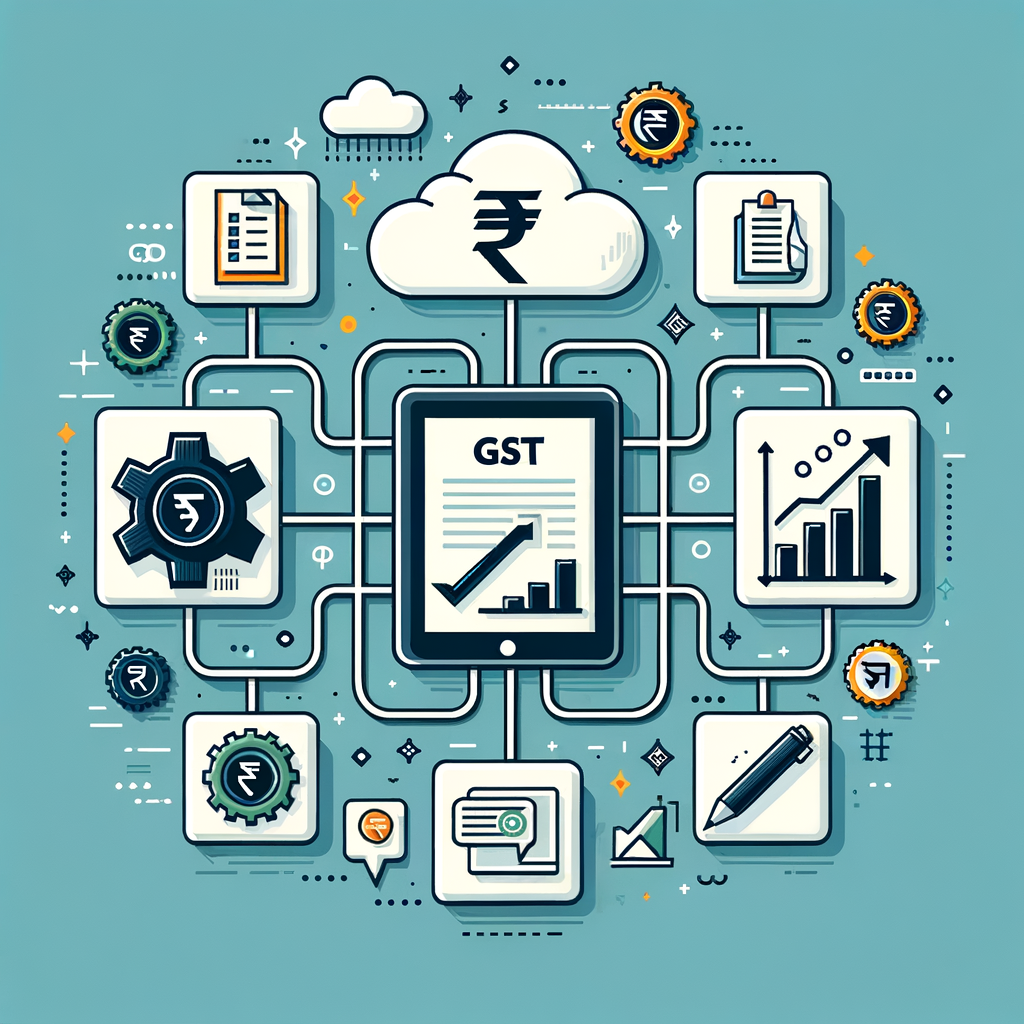Leveraging Digital Tools for Seamless GST Return Management
Introduction: The End of Manual GST Hassles
For small business owners across India, the Goods and Services Tax (GST) regime can often feel like a double-edged sword. While it streamlines indirect taxation, the compliance process—especially filing returns like GSTR-1 and GSTR-3B—can be a significant burden. The tedious cycle of manual data entry, painstaking invoice reconciliation, and the constant anxiety of making costly errors are all too familiar. However, this complex and time-consuming process is rapidly being transformed by technology. The rise of sophisticated digital tools for GST management is revolutionizing how businesses handle their tax obligations, turning a dreaded chore into a streamlined, efficient, and error-free activity. This comprehensive guide is designed to walk you through the entire journey, from understanding the pitfalls of manual filing to selecting and implementing the perfect software. By the end, you will have a clear roadmap to achieving seamless GST return filing solutions, ultimately saving your business precious time, money, and resources.
Why Manual GST Filing Is Holding Your Business Back
Before diving into the solution, it’s crucial to understand the problem. Relying on manual methods like spreadsheets and physical record-keeping for GST compliance isn’t just inefficient; it’s a significant risk to your business’s financial health and growth potential. The complexities of the GST framework, combined with the fallibility of human processes, create a perfect storm for errors, wasted time, and compliance failures. Let’s break down the specific ways in which manual GST filing can actively hinder your progress and expose you to unnecessary liabilities.
The High Cost of Human Error
In the world of tax compliance, even the smallest mistake can have significant financial repercussions. When you rely on manual data entry, the probability of human error increases exponentially. A simple typo in an invoice number, an incorrect GSTIN, or a miscalculation of tax liability can lead to a mismatch notice from the GST department. These errors often result in the incorrect payment of taxes, which can trigger penalties and interest charges. Under the GST Act, interest is levied for delayed tax payments, and hefty penalties can be imposed for incorrect filings or tax evasion. For instance, a mistake in classifying a product with the wrong HSN code could lead to an incorrect tax rate being applied, resulting in underpayment of tax and subsequent departmental action. These financial penalties are not just one-time costs; they can accumulate over time, creating a substantial drain on your working capital and profitability.
The Time Sink: Lost Productivity and Focus
One of the most significant hidden costs of manual GST filing is the sheer amount of time it consumes. Consider the hours your team spends every month on non-core, administrative tasks: manually entering sales and purchase data into spreadsheets, cross-referencing every purchase invoice against the details in GSTR-2A/2B to claim Input Tax Credit (ITC), and painstakingly navigating the government portal to upload data. For those navigating this process, a detailed walkthrough can be invaluable; see our How to File GST Returns Online: A Step-by-Step Guide of the GST Filing Process & Procedure. This time represents a massive opportunity cost. These are hours that could be dedicated to strategic business activities like product development, customer engagement, marketing, or exploring new growth avenues. Instead, your most valuable resource—your time—is tied up in clerical work. This lost productivity directly impacts your company’s ability to innovate and compete effectively, turning your compliance process into a bottleneck for growth rather than a smooth back-end operation.
The Challenge of Staying Compliant
The GST framework in India is not a static system; it is dynamic and subject to frequent amendments, clarifications, and procedural changes. The government regularly issues notifications and circulars that can alter tax rates, reporting requirements, and return filing procedures. For a business owner focused on day-to-day operations, keeping track of every single update across Central GST (CGST), State GST (SGST), and Integrated GST (IGST) rules is a monumental challenge. Relying on manual processes means you are solely responsible for staying updated and correctly implementing these changes. A missed notification could lead to non-compliance, resulting in legal notices and potential audits. To stay informed, businesses must constantly monitor official sources like the official GST portal, adding another layer of complexity and responsibility to an already demanding process.
The Power of Digital Tools for GST Management: An Overview
The solution to the challenges of manual compliance lies in technology. Digital tools for GST management are specifically designed to automate and simplify the entire GST lifecycle, from invoice creation to final return submission. These tools act as a bridge between your business operations and the government’s GST Network (GSTN), ensuring accuracy, efficiency, and peace of mind. As businesses increasingly look for GST return filing software for businesses, understanding what these tools are and what they can do is the first step towards transforming your compliance strategy. It is also beneficial to understand the wider landscape of Digital Tools Every Business Should Use for Tax Management. They represent a fundamental shift from reactive, manual data handling to a proactive, automated system that puts you in control.
What Are Online GST Management Tools?
At their core, online GST management tools India are specialized software applications, available as both desktop installations and, more commonly, as cloud-based platforms. They are engineered to handle every facet of GST compliance. Unlike generic accounting software that may have basic GST functionalities, these dedicated tools are built from the ground up to address the specific nuances of the Indian GST system. Cloud-based solutions, in particular, offer immense advantages for modern businesses. They provide the flexibility to access your GST data from anywhere, at any time, on any device. Furthermore, they automatically update in the background to reflect the latest changes in GST laws and forms, ensuring you are always compliant without any manual intervention. This eliminates the risk of using outdated forms or applying incorrect rules, a common issue with manual or offline systems.
Core Features That Make a Difference
The true power of GST software lies in its features, which are designed to tackle the biggest pain points of manual filing. When evaluating a solution, look for these core functionalities that deliver the most significant impact:
- Automated Data & Invoicing: The best tools allow you to create professional, GST-compliant invoices directly within the platform. The software automatically extracts all relevant data from these invoices—such as customer GSTIN, HSN codes, and tax amounts—and organizes it for return preparation, eliminating the need for manual data entry.
- Real-time Reconciliation: This is arguably the most valuable feature. The software automatically fetches your GSTR-2A and GSTR-2B data from the GST portal and compares it with your purchase records. It instantly flags any mismatches, allowing you to follow up with suppliers and ensure you claim 100% of your eligible Input Tax Credit (ITC). This single feature can lead to substantial direct savings for your business.
- Direct & Error-Free Filing: The software uses the validated and reconciled data to auto-populate your GSTR-1 and GSTR-3B returns. Built-in validation checks catch potential errors before submission. Most advanced tools are integrated with GST Suvidha Providers (GSPs), enabling you to file your returns directly to the GSTN with a single click, bypassing the need to manually log in and upload data on the government portal.
- Comprehensive Reporting: Gain deeper insights into your business’s financial health with powerful reporting features. These tools can generate detailed reports on sales trends, purchase patterns, ITC claims, pending tax liabilities, and cash flow. This data is invaluable for making informed business decisions and for preparing for any potential audits.
How to Select the Best GST Return Filing Software for Your Business
With a plethora of options available in the market, choosing the right GST return filing software for businesses can seem daunting. The key is to select a tool that not only meets your current needs but can also grow with your business. A systematic evaluation based on your specific requirements will ensure you invest in a solution that provides long-term value. Instead of being swayed by marketing claims, focus on a few critical parameters that will determine the software’s suitability for your unique operational workflow.
Assess Your Business Needs & Scalability
The first step is to conduct a thorough internal assessment. A freelancer with a handful of invoices per month has vastly different requirements than a small manufacturing unit processing hundreds of transactions. Consider key factors such as your monthly transaction volume, the complexity of your sales and purchases, and the number of users who will need access to the software. Ask yourself critical questions: Does your business operate in multiple states, requiring you to manage different GSTINs? Do you deal with special transactions like exports or reverse charge mechanisms? It’s also vital to think about the future. Choose a software solution that is scalable and can handle an increasing volume of transactions as your business grows, so you don’t have to switch platforms in a few years.
Check for Integration Capabilities
A GST software solution should not operate in a silo. For maximum efficiency, it must integrate seamlessly with the other software you already use, especially your accounting system. If your business relies on platforms like Tally, Zoho Books, QuickBooks, or any other ERP software, check if the GST tool offers pre-built integrations or APIs. This capability is crucial because it allows for an uninterrupted flow of financial data, eliminating the need for duplicate data entry and reducing the risk of errors that can occur when transferring information between systems. A well-integrated system ensures that your accounting records and GST filings are always in sync, providing a single source of truth for all your financial data. This underscores the importance of Maintaining Accurate Accounting Records for Tax Purposes.
Prioritize Data Security and Support
When you entrust your sensitive financial data to a third-party application, security is non-negotiable. Scrutinize the security protocols of any software you consider. Look for features like end-to-end data encryption, secure cloud hosting on reputable servers (like AWS or Azure), and regular security audits. Ensure the provider has a clear data privacy policy that outlines how your information is stored and protected. Equally important is the quality of customer support. GST compliance can be complex, and you may encounter technical issues or have questions about specific features. A reliable and responsive customer support team—accessible via phone, email, or chat—can be a lifesaver when you’re facing a filing deadline. Check reviews and testimonials to gauge the provider’s reputation for support before making a final decision.
Leveraging Digital Solutions for GST India: A Step-by-Step Implementation Guide
Choosing the right software is only half the battle; successfully implementing it is what truly unlocks its potential. A structured implementation plan ensures a smooth transition from manual processes to an automated workflow, minimizing disruption and maximizing efficiency. This is the core of leveraging digital solutions for GST India effectively. By following a clear, step-by-step process, you can integrate the new tool into your operations and start reaping the benefits almost immediately. This approach is one of the most innovative GST management strategies for India‘s small and medium-sized enterprises.
Step 1: Smooth Data Migration
The first and most critical step is to move your existing data into the new system. Most reputable GST software providers offer tools or assistance for data migration. Begin by exporting your master data—such as lists of customers, vendors, products, and services with their HSN/SAC codes—from your old system or spreadsheets. Import this information into the new software. Next, decide on a cut-off date and import historical transaction data (sales and purchase invoices) up to that point. A clean and accurate data migration is fundamental to the software’s performance. Take the time to verify the imported data to ensure there are no discrepancies that could affect future filings.
Step 2: Automate Your GST Workflow
Once your data is in place, it’s time to redefine and automate your compliance workflow. This is where you will see the most significant gains in efficiency. The ideal automated process should look like this:
- Generate Invoices: Start creating all your sales invoices directly within the new GST software. This ensures all necessary data is captured correctly at the source.
- Run Automated Reconciliation: Schedule the software to run its automated ITC reconciliation process at regular intervals, such as weekly. This allows you to identify and resolve invoice mismatches with your suppliers well before the filing deadline.
- Review Auto-Generated Returns: At the end of the tax period, the software will use the validated data to auto-prepare your GSTR-1 and GSTR-3B. Your role shifts from data entry to one of review and verification.
- File with a Single Click: After a final review, use the software’s direct filing feature to submit your returns to the GSTN securely and instantly.
Step 3: Train Your Team and Review Performance
A tool is only as good as the people who use it. Invest time in training your team members—whether it’s your accountant or other administrative staff—on how to use the new software effectively. Most software providers offer training materials, webinars, or dedicated support to help with this. Ensure everyone understands the new, automated workflow and their role within it. After the initial implementation, schedule periodic reviews (e.g., quarterly) to assess the tool’s performance. Are you saving time? Is your ITC claim maximized? Are you filing returns without errors? This feedback loop will help you fine-tune your processes and ensure you are getting the maximum return on your investment.
Conclusion: Embrace a Smarter Way to Manage GST
In today’s competitive business landscape, efficiency is key to survival and growth. The days of wrestling with complex spreadsheets and spending countless hours on manual GST compliance are over. The adoption of digital tools for GST management is no longer a luxury but a strategic necessity for any forward-thinking Indian business. By automating data entry, streamlining reconciliation, and ensuring error-free filing, these tools deliver a powerful combination of benefits: significantly reduced errors, substantial time savings, maximized Input Tax Credit, and, most importantly, the peace of mind that comes with guaranteed compliance. Making the switch is a proactive investment in your business’s operational excellence and financial stability.
Feeling overwhelmed by GST compliance? Let TaxRobo help you find the perfect seamless GST return filing solutions for your business. Contact our experts today for a free consultation and take the first step towards smarter, simpler tax management!
Frequently Asked Questions (FAQ)
1. Are these digital GST tools expensive for a small business?
Not at all. The market for GST software is highly competitive, which is great for consumers. Many providers offer tiered pricing models specifically designed to be affordable for businesses of all sizes. You can often find basic plans for freelancers and micro-businesses that cost a fraction of what you would pay for manual accounting services or the cost of a single penalty. When you consider the savings from maximized ITC, avoided penalties, and reclaimed productive hours, the software often pays for itself many times over.
2. Can I file my GST returns directly from this software?
Yes, this is one of the key advantages. Most modern GST software solutions are integrated with officially recognized GSPs (GST Suvidha Providers) or use direct APIs provided by the GSTN. This integration allows you to submit your GSTR-1 and GSTR-3B returns directly from the software’s dashboard with a single click. This eliminates the need to separately log in to the government’s GST portal, download JSON files, and upload them manually, which simplifies the process and reduces the chances of last-minute portal-related issues.
3. How secure are my business’s financial data with these tools?
Reputable software providers make data security their top priority. They employ industry-standard security measures to protect your sensitive financial information. This typically includes end-to-end data encryption (both in transit and at rest), secure hosting on robust cloud platforms like Amazon Web Services (AWS) or Microsoft Azure, and regular security audits. Before choosing any online GST management tools India, always review their security policy and ensure they are using trusted technologies to safeguard your data.
4. What is the difference between accounting software and dedicated GST software?
This is an excellent question. While many popular accounting software packages (like Tally or Zoho Books) have modules for GST compliance, a dedicated GST software offers more specialized and advanced features. Accounting software is designed to manage your entire financial operations, with GST being just one component. Dedicated GST software, on the other hand, is built specifically for deep compliance. It often provides superior features like advanced AI-powered invoice reconciliation against GSTR-2B, automated vendor communication tools for mismatch resolution, and more detailed compliance-specific reports that basic accounting tools may lack. For businesses with higher transaction volumes or more complex GST needs, a dedicated tool is often the better choice.



